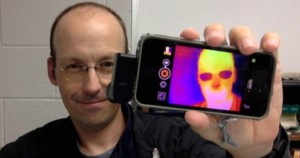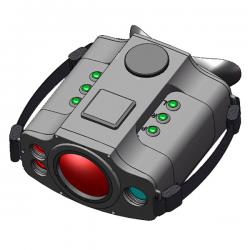Thermal imaging cameras are technically not cameras, but rather sensors that detect heat (also called thermal energy or infrared). Technically, these devices are detecting radiation. The amount of this radiation goes up with the temperature.
With enough precision a thermal imager can see minute differences in heat and represent this as an image (or thermogram) on a screen. The temperature differences detectable on some of the world’s most sophisticated devices can be as small as 0.01°C. Various colors are used to represent temperatures so when you see a black and white thermal image the lighter the color, the hotter the object (newer thermal imagers can invert this or use a wide variety of colors). Human beings, animals and cars generate heat and are usually warmer than their surroundings, allowing the user of a thermal imager to get a good look at them. A coldblooded animal such as a snake will be harder to see because their body temperature adjusts to their surroundings.
Because they detect radiation, thermal imagers do not require any visible light to produce an image.
Firefighters
Thermal imagers can, to some degree, see through smoke and debris, allowing firefighters to find people who have passed out because of smoke inhalation, or children who are hiding in closets and too afraid to come out. A thermal imager can also tell a firefighter if a door is hot and possibly contains a fierce blaze on the other side.
Thermal Imaging Uses: Hunting
Hog hunters are especially fond of thermal imagers. Wild hogs can be extremely destructive, especially to farms, but they’re also clever. They rarely go out during the day, and have the benefit of tree or plant cover in many areas. Farmers hunting hogs to protect their farms often use thermal imagers. They can see past their crops to find the animal underneath. Hunters also love thermal imagers for finding hidden deer. As an easy to carry and use thermal imager, hunters are able to scan the field for long periods of time without arm fatigue. This is an important feature to look for if you plan on using your thermal imager for long periods of time.
Military and Police
One of the most common users of a thermal imager is a law enforcement or military professional. They need to be able to see potential threats without being detected and thermal units give them this chance. Modern thermal imaging technology is tough enough to withstand the abuse of recoil, so many police officers and soldiers now employ thermal imaging rifle scopes such as the ATN ThOR 640 Thermal Imaging Weapon Sight. The drawback of using thermal imagers in life-and-death situations is that while they’re incredibly effective at detecting people or animals, identification is far more challenging. You may see a man in front of you, but this doesn’t mean you’ll be able to tell if he’s a friend or a foe.
Surveillance
Thermal imaging cameras are one of the most effective tools for surveillance because they work equally well in the day and night. A regular CCTV camera is limited by its need for light, and night vision doesn’t function during the day. The chance to see through smoke and fog also gives thermal a leg up on other surveillance techniques.
Energy Audits
Heating and cooling companies have used thermal imagers for years to see where buildings are leaking heat. Small cracks or holes cause homes to lose hundreds of dollars a year on heating and cooling bills.
Deer Spotting
Thermal imagers that mount behind the grill of a car or anywhere near the front of a vehicle to allow the user to spot deer or other wildlife that can potentially run out into the road. Many people die every year swerving to avoid hitting a deer, and these devices help lessen the danger.
This article comes from opticsplanet edit released

